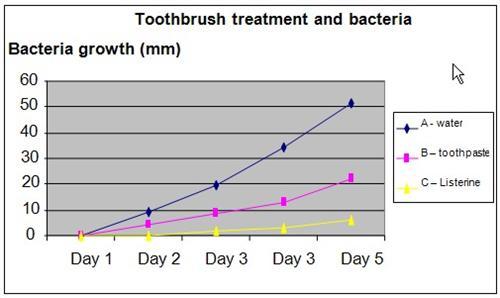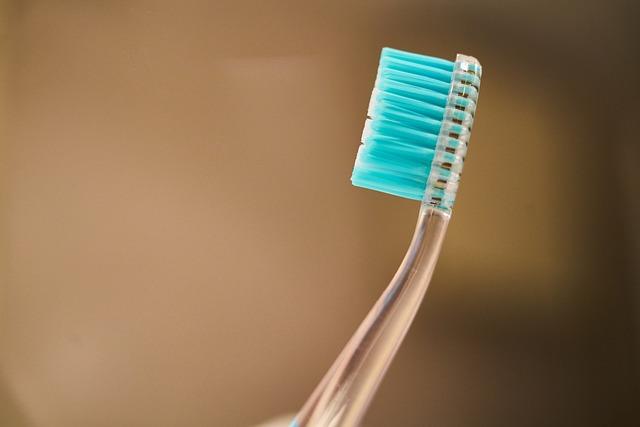| Complexity level: | 7 |
| Project cost ($): | 20 |
| Time required: | 5 days to prepare, 5 days for science fair project |
| Material availability: | Easily found |
| Safety concerns: | Basic safety requirements |
Hypothesis
The toothbrush kept in Listerine solution will have the least bacteria.
Overview
Mouth bacteria
Our mouth is filled with plenty of micro-organisms like bacteria, protozoa, fungi and viruses. They are found in the walls of our mouth, our tongue, throat and all the way down to our stomach and intestines. Most of these microbes are harmless and they find our body to be very hospitable.
It is estimated that there are about 60 types of microbes out of about 100million of them in 1 milliliter of saliva. Most of these bacteria are swallowed by us together with the food and water that we consume. However, most of them are killed by the enzymes in our stomach and in our saliva
Some of the common types of bacteria in our mouth are Streptococcus mutans and Porphyromonas gingivalis. Streptococcus mutans are responsible for tooth decay by producing acids that will dissolve the enamel when they digest sugar and starch that are sticking to the teeth. Porphyromonas gingivalis are responsible for gum diseases.
Scientific Terms
Materials
The materials required for the science fair project experiment:
- 3 agar petri dishes prepared with agar
- 3 disinfected swabs
- 1 bottle of disinfected water
- 3 toothbrushes
- 1 bottle of Listerine
- 1 tube of toothpaste
- 1 Marker pen
Procedure
1. For this science fair project, the independent variable is the treatment given to the toothbrush before bacteria samples are taken from it. The dependent variable is the rate of bacteria growth in the petri dish. This is determined by measuring the size of the bacteria colony using a ruler. The constants (control variables) are the room temperature, the amount of sunlight and the ingredients of the petri dish agar.
2. The 3 petri dishes prepared with agar, are stored in a refrigerator. The petri dishes are brought to room temperature before the start of the science fair project by taking them out of the refrigerator and allowing them to attain room temperature. The petri dishes are labeled A, B and C.
3. The toothbrushes are also labeled A, B and C. They are given the following treatment for 5 days before starting the science project experiment.
a. Toothbrush A – is used to brush teeth 2 times a day for 5 days with only water. After brushing the toothbrush is kept in an empty cup.
b. Toothbrush B – is used to brush teeth 2 times a day for 5 days using toothpaste. After brushing the toothbrush is kept in an empty cup.
c. Toothbrush C - is used to brush teeth 2 times a day for 5 days using toothpaste. After brushing the toothbrush is kept in a cup filled with Listerine.
4. The sterilized swab is first made damp with the sterilized water. The swabs are rubbed all over the toothbrushes and then rolled in the petri dishes according to the marking in the petri dish and the toothbrush.
5. The cover is closed and the 3 petri dishes are kept in a cool shaded place for the bacteria to grow.
6. The diameter of the bacteria colony growth is measured everyday for 5 days and recorded in the below table.

Results
The results show that the petri dish A had the quickest bacteria growth. Toothbrush C (dipped in Listerine) had the least amount of bacteria growth.
|
Petri Dish type |
Size of bacteria growth (mm) |
||||
|
Day 1 |
Day 2 |
Day 3 |
Day 3 |
Day 5 |
|
|
A - water |
0 |
8.9 |
19.5 |
34.3 |
51.2 |
|
B – toothpaste |
0 |
4.1 |
8.3 |
12.7 |
22.1 |
|
C – Listerine dip |
0 |
0 |
1.9 |
3.2 |
6.3 |
The graph below represents the results of our science project experiment.

Conclusion
The hypothesis that toothbrushes kept in Listerine solution have the least amount of bacteria, is proven to be true.
Proper tooth brushing techniques will help to get rid of plaque and bacteria that are responsible for tooth decay and gum disease. Using toothpaste which contains fluoride helps to strengthen one's teeth against decay. It also helps to remove stains from the teeth and gives us clean, fresh breath.
Also consider
To improve the reliability and accuracy of our results, a larger sample of participants should be used.
This science fair project may be repeated, this time, with taking a swab sample from the mouth after gargling with water, gargling with mouth wash and gargling with Listerine and comparing the bacteria content.
Modify the science project experiment, using saltwater, lime juice and sterilized water.
References
Mouth bacteria, it’s a jungle in there - http://www.brighthub.com/science/genetics/articles/45935.aspx
Toothpaste - http://www.dentalgentlecare.com/toothpaste.htm

